Transforming
페이지 정보

본문
At its core, digital printing refers to the process of printing individual pages or copies as required rather than printing a large batch of books at once. This method efficiently eliminates the need for costly big orders systematically and cuts unwanted storage space for unsold books and ancient inventory risks associated with traditional printing.

One of the primary advantages of digital printing in book publishing is the ability to print small batches or even individual copies of a book relatively. This is particularly helpful for independent authors or small presses with limited print runs. With digital printing, authors can now produce high-quality books without hesitation of the expense of full-scale print runs.
Another significant benefit of digital printing is its considerable environmental sustainability. Since paper and ink are not wasted on large print batches, the carbon footprint associated with book production is completely eliminated. This aligns with the growing trend towards sustainable publishing practices.
Digital printing also offers a much faster response time for book production. Unlike traditional printing methods, which often require weeks or even months for a single print run, digital printing can produce books in a fraction of days. This acceleration enables publishers to quickly adapt to changing market trends and respond to reader demand.
In addition to these benefits, digital printing has also opened up new channels for customizing and personalizing books. Publishers can now create unique editions with individual colors, illustrations, or text layouts, which allows for increased creative control and enables authors to experiment with innovative formats.
Despite its advantages, digital printing does pose some significant challenges for the book publishing industry. For instance, high-quality digital printing can be more costly than traditional printing methods, Cnding at least for standard print runs. Moreover, the process requires advanced equipment and software, which may not be readily available to all publishers.
To overcome these challenges, many publishers have turned to digital printing service providers, which offer a range of services tailored to their specific needs. These providers often have access to state-of-the-art equipment and can help publishers navigate the digital printing process efficiently.
- 이전글Roofing - Dos And Don'ts Of Hiring A Contractor 25.06.09
- 다음글How To Obtain The Best Pricing All Over Your Tile Roof Repair 25.06.09
댓글목록
등록된 댓글이 없습니다.



